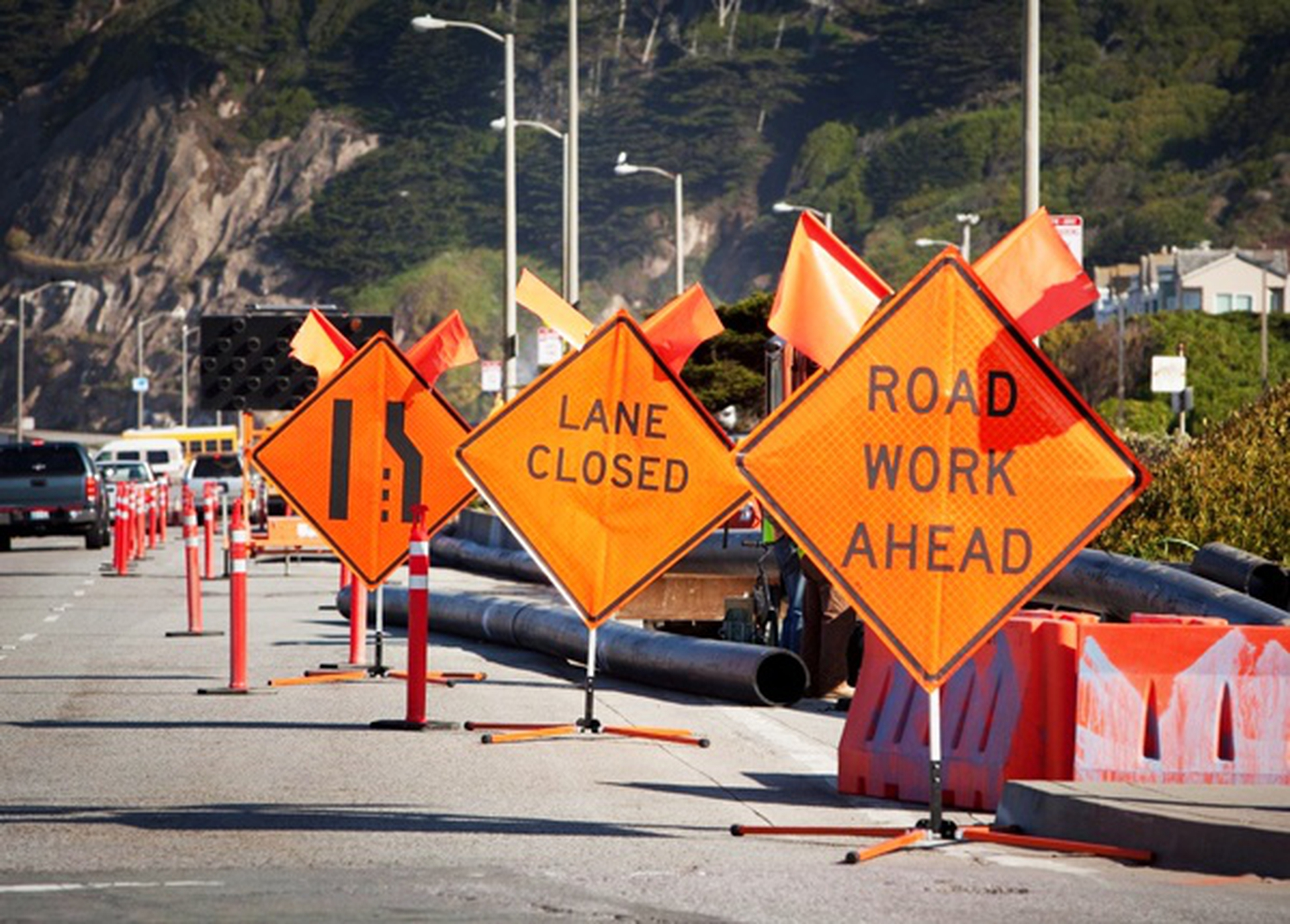Construction sites, with their bustling activity and heavy machinery, can be hazardous environments. Amidst the controlled chaos, construction warning signs stand as silent guardians, providing crucial guidance for navigating these potentially dangerous areas. This comprehensive guide delves into the language of safety on construction sites, exploring the types of signs, their meanings, and their effectiveness in preventing accidents.
Construction Warning Signs: Your Guide to Staying Safe
Imagine construction warning signs as a universal language spoken through vibrant colors, clear symbols, and concise text. These signs are strategically placed throughout construction sites to ensure the safety of workers, visitors, and the public. Understanding their message is crucial for maintaining a safe work environment.
Colors That Speak: The Language of Safety
Construction signs use a color-coding system similar to traffic signals, instantly conveying the level of hazard or required action.
- Red: Danger Zone – Stop! Red signals imminent danger, demanding immediate attention. Areas marked with red often indicate high-voltage zones, prohibited access points, or situations requiring a complete halt.
- Yellow: Proceed with Caution – Be Alert! Yellow signifies potential hazards, prompting caution and awareness. These signs often mark slippery surfaces, uneven terrain, or areas with moving equipment.
- Blue: Mandatory Actions – Safety First! Blue signs convey mandatory safety instructions. They often depict required personal protective equipment (PPE) such as hard hats, gloves, or safety glasses.
- Green: The “All Clear” Signal – Safe Passage. Green indicates safety, marking safe walkways, first aid stations, and emergency exits. These signs guide individuals toward designated safe zones.
Types of Signs and Their Meanings
Construction warning signs are categorized based on their purpose and the actions they require. Each type uses specific shapes and symbols for quick recognition.
- Prohibition Signs (Red Circle with White Bar): The “No-Nos” – These signs forbid certain actions, such as entering restricted areas, smoking, or using open flames.
- Mandatory Signs (Blue Circle with White Symbol): Safety First – These signs enforce necessary safety precautions, like wearing specific PPE or following designated routes.
- Warning Signs (Yellow Triangle with Black Border): Potential Hazards Ahead – These signs alert individuals to potential dangers, encouraging caution and appropriate safety measures.
- Safe Condition Signs (Green Rectangle or Circle): Your Guide to Safety – These signs indicate areas or equipment deemed safe for use, providing guidance and reassurance.
- Fire Equipment Signs (Red Square or Rectangle): In Case of Emergency – These signs mark the location of fire extinguishers, fire alarms, and other fire safety equipment, crucial for emergency preparedness.
Key Points:
- Construction warning signs use colors and symbols to indicate potential dangers.
- Red signs signal immediate danger, yellow signs indicate caution, and green signs highlight safe practices.
- OSHA and ANSI set regulations for warning signs to ensure consistency in safety messaging.
- Customized signs can address unique hazards not covered by generic signs (e.g., deep excavations).
- Consider digital warning signs that can adapt to changing conditions or specific tasks.
- Pay attention to construction signs to identify hazards and stay safe.
What Are the Different Types of Construction Warning Signs?
Construction warning signs serve as visual guides, providing essential information to mitigate risks and ensure safety. These signs, categorized by their specific purposes, play distinct roles in maintaining a secure work environment.
1. Prohibition Signs (The “No-Nos” – Red Circle with White Bar)
These signs act as strict guardians, clearly indicating prohibited actions or areas. The red circle with a diagonal slash serves as a universal symbol for “forbidden.”
- Examples: No entry for unauthorized personnel, no smoking, no open flames.
2. Mandatory Signs (The “Must-Dos” – Blue Circle with White Symbol)
Mandatory signs emphasize essential safety precautions that must be followed before entering or working within designated areas.
- Examples: Must wear a hard hat, eye protection required, safety harness must be worn.
3. Warning Signs (Heads-Up! – Yellow Triangle with Black Border)
These signs act as alerts, drawing attention to potential hazards and prompting caution.
- Examples: Falling objects, risk of electrical shock, forklift traffic.
4. Safe Condition Signs (All Clear! – Green Rectangle or Circle)
Green signifies safety, and these signs guide individuals toward safe zones or practices.
- Examples: First aid station, emergency exit, designated assembly area.
5. Fire Equipment Signs (In Case of Emergency – Red Square or Rectangle)
Crucial during emergencies, these signs clearly mark the location of fire safety equipment.
- Examples: Fire extinguisher, fire hose, fire alarm pull station.
Why Does It Matter?
Understanding these signs is fundamental to maintaining a safe construction site. They provide a visual language understood by all, regardless of language barriers or experience levels.
Minimum 4 Key Lines:
- Construction warning signs serve as visual cues to identify potential hazards, enhance safety, and comply with regulations.
- These signs come in various categories:
- Prohibition (red circle with white bar)
- Mandatory (blue circle with white symbol)
- Warning (yellow triangle with black border)
- Safe condition (green rectangle or circle)
- Fire equipment (red square or rectangle)
- Warning signs alert workers to specific hazards, while prohibition signs forbid certain actions and mandatory signs enforce necessary precautions.
- Adhering to construction warning signs reduces accidents, promotes safe work practices, and establishes clear communication on construction sites.
Understanding the Color Codes and Symbols on Construction Warning Signs
Construction warning signs go beyond mere text, employing a powerful combination of color codes and symbols to communicate effectively.
Cracking the Code: Colors on Construction Signs
As mentioned earlier, colors play a crucial role in conveying the level of hazard or required action.
- Red: Danger Zone! Red demands immediate attention, indicating a situation where severe harm or death is possible.
- Yellow: Heads Up! Yellow encourages caution, highlighting potential hazards that require awareness and appropriate safety measures.
- Blue: Rules to Follow. Blue signifies mandatory actions, emphasizing essential safety precautions for the specific area.
- Green: The “All Clear” Signal. Green provides guidance and reassurance, indicating safe zones and practices.
Types of Signs and What They Mean
Each sign type combines a specific shape, color, and often a symbol to clearly convey its message.
- Prohibition Signs (Red): The “No-Nos.” These signs prohibit specific actions to prevent hazards.
- Mandatory Signs (Blue): Safety First. These signs mandate specific actions to ensure safety, often related to PPE.
- Warning Signs (Yellow): Potential Hazards Ahead. These signs alert individuals to potential dangers, promoting proactive safety measures.
- Safe Condition Signs (Green): Your Guide to Safety. These signs guide individuals toward safe practices and areas.
- Fire Equipment Signs (Red): In Case of Emergency. These signs ensure quick access to fire safety equipment during emergencies.
Why Understanding Signs Matters
Construction sites rely on a shared understanding of safety protocols. Warning signs provide this shared language, enabling everyone on site to identify hazards, follow safety procedures, and respond appropriately to emergencies.
Key Lines:
- Construction safety signs leverage color codes and symbols to convey critical safety information, enhancing safety by quickly alerting workers to potential hazards and instructing them on appropriate actions.
- The color codes used in construction safety signs are standardized by OSHA, with specific colors assigned to denote different hazard levels and safety instructions.
- Understanding the color codes and symbols of construction safety signs is vital for workers to recognize and respond to hazards, ensuring a safe work environment.
- These signs and symbols are categorized into distinct types, each serving a specific purpose (e.g., prohibition, mandatory, warning) and using consistent colors for quick recognition.
How Effective Are Construction Warning Signs in Preventing Accidents?
Construction warning signs are essential tools for preventing accidents, serving as constant visual reminders of potential hazards and safety procedures.
Visual Cues for Enhanced Safety:
The effectiveness of construction warning signs lies in their ability to:
- Provide Quick & Clear Communication: Color codes and symbols allow for instant hazard recognition, even from a distance.
- Act as Guides & Protectors: They guide workers along safe paths, clearly mark hazardous areas, and provide concise safety instructions.
- Serve as Safety Champions: They promote a safety-conscious culture by constantly reinforcing safety protocols and reminding workers to stay alert.
Compliance and Risk Reduction:
When implemented and maintained correctly, construction warning signs significantly contribute to:
- Reduced Accident Rates: By increasing hazard awareness and promoting safe practices, these signs help prevent accidents.
- Improved Compliance with Regulations: Adhering to signage standards ensures compliance with OSHA and ANSI regulations, minimizing liability and promoting a safe work environment.
- Enhanced Communication and Coordination: Clear and consistent signage improves communication among workers, contractors, and visitors, fostering a safer and more efficient work environment.
Here’s the gist of why those signs are so important:
- Quick & Clear Communication: They use a simple color-coded system and easy-to-understand symbols to quickly get the safety message across.
- Guides & Protectors: They lead people along safe paths, clearly mark dangerous areas, and offer quick instructions to prevent mishaps.
- Safety Champions: By giving clear warnings and reminders, they help workers stay safe and ensure everyone’s playing by the official safety rules.
Key Lines:
- Construction signs serve as a critical safety measure, clearly indicating hazardous areas, guiding safe pathways, and conveying important safety instructions.
- Safety signs in construction environments promote awareness, mitigate hazards, and protect workers and visitors from potential injuries and accidents.
- Construction signage plays a pivotal role in effective project management, ensuring adherence to regulations, minimizing risks, and enhancing communication among stakeholders.
- By providing visual cues and warnings, safety signs empower construction workers to make informed decisions and act proactively to prevent accidents.
For those seeking further information on construction site safety, OSHA provides detailed guidelines on warning signs:
OSHA Safety and Health Topics – Warning Signs.
Want to learn more about the construction industry? Check out these resources:
- For a comprehensive overview of a company profile for construction site, explore our detailed guide.
- Looking for information on building regulations application mezzanine office? Our site offers a complete guide.
- For insights into the equipment used in road construction, we provide comprehensive information on various types and their applications.
- Best Backsplash For White Cabinets: Ideas To Transform Your Kitchen - November 24, 2025
- Modern White Kitchen Backsplash: A Guide to Stylish Kitchen Designs - November 23, 2025
- White Backsplash Ideas: Simple Ways to Refresh Your Kitchen Space - November 22, 2025










